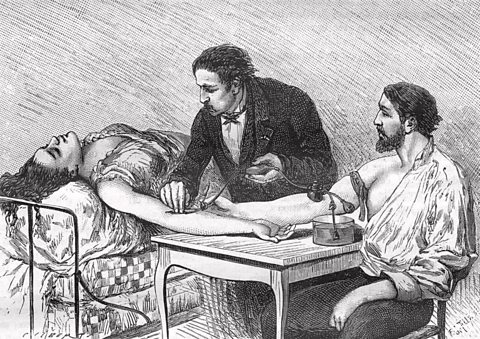Before the 1900s, severe blood loss almost always meant certain death. In the early years of blood transfusions, before safe methods were discovered, most recipients were expected to die. Blood was difficult to work with and coagulated and doctors were unaware of blood types, thus resulting in the person’s antibodies wreaking havoc on their internal organs. People were also suspicious of receiving human blood during the cholera outbreak and were afraid to “catch” other people’s mental illnesses through their blood. Naturally, to remedy these problems doctors began looking for a blood substitute.

In 1854, Dr. James Bowell and Dr. Edwin Hodder, announced their belief that the fatty acids and oily properties of milk made it a promising option. They thought that the fat in the milk could develop into white blood cells once introduced to the bloodstream. The first milk transfusion was done on a 40-year old patient who was given an injection of 12 ounces. They were reported to have reacted very well to the treatment. Others would not be so lucky. Five subsequent patients underwent milk transfusions and died. Many doctors tried a variety of milk, hoping to land on one compatible with the human body; cow, goat, even human.
Dr. Joseph Howe experimented with dogs to test the safety of using milk as a substitute. He drained blood from multiple dogs until they passed out and injected them with milk. All of the dogs died. Although some newspapers and medical journals did publish positive results to milk transfusions, there was an overwhelming amount of reported complications. The milk caused severe headaches, chest pain, involuntary eye movements, comas, and of course, death. By 1884 milk transfusions were deemed a failure and pretty much abandoned altogether. Luckily, by the turn of the century, blood types were discovered, thus making actual blood transfusions safer and more reliable. Nowadays, it’s recommended to drink milk, not inject it.
Until Next Time
Davis, Matt. “19th-Century Medicine: Milk Was Used as a Blood Substitute for Transfusions.” Big think. 17 April, 2019. Accessed 14 January, 2024. bigthink.com/health/milk-transfusion.
The Ashland union. [volume] (Ashland, Ashland County, Ohio), 09 May 1855. Chronicling America: Historic American Newspapers. Lib. of Congress. <https://chroniclingamerica.loc.gov/lccn/sn83035173/1855-05-09/ed-1/seq-1/>